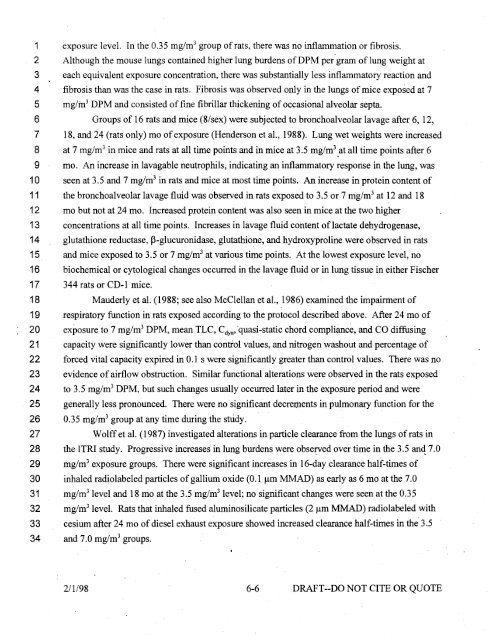Health Assessment Document for Diesel Emissions - NSCEP | US ...
Health Assessment Document for Diesel Emissions - NSCEP | US ...
Health Assessment Document for Diesel Emissions - NSCEP | US ...
You also want an ePaper? Increase the reach of your titles
YUMPU automatically turns print PDFs into web optimized ePapers that Google loves.
1 exposure level. In the 0.3 5 mg/m 3 group of rats, there was no inflammation or fibrosis.<br />
2 Although the mouse lungs contained higher lung burdens of DPM per gram of lung weight at<br />
3 each equivalent exposure concentration, there was substantially less inflammatory reaction and<br />
4 fibrosis than was the case in rats. Fibrosis was observed only in the lungs of mice exposed at 7<br />
5 mg/in 3 DPM and consisted of fine fibrillar thickening of occasional alveolar septa.<br />
6 Groups of 16 rats and mice (8/sex) were subjected to bronchoalveolar lavage after 6, 12,<br />
7 18, and 24 (rats only) mo of exposure (Henderson et al., 1988). Lung wet weights were increased<br />
8 at 7 mg/m 3 in mice and rats at all time points and in mice at 3.5 mg/m 3 .at all time points after 6<br />
9 mo. An increase in lavagable neutrophils, indicating an inflammatory response in the lung, was<br />
10 seen at 3.5 and 7 mg/m 3 in rats and mice at most time points. An increase in protein content of<br />
11 the bronchoalveolar lavage fluid was observed in rats exposed to 3.5 or 7 mg/m 3 at 12 and 18<br />
12 mo but not at 24 mo. Increased protein content was also seen in mice at the two higher<br />
13 concentrations at all time points. Increases in lavage fluid content of lactate dehydrogenase,<br />
14 glutathione reductase, P-glucuronidase, glutathione, and hydroxyproline were observed in rats<br />
15 and mice exposed to 3.5 or 7 mg/m 3 at various time points. At the lowest exposure level, no<br />
16 biochemical or cytological changes occurred in the lavage fluid or in lung tissue in either Fischer<br />
17 344 rats or CD-I mice.<br />
18 Mauderly et al. (1988; see also McClellan et al., 1986) examined the impairment of<br />
19 respiratory function in rats exposed according to the protocol described above. After 24 mo of<br />
20 exposure to 7 mg/m 3 DPM, mean TLC, Cdyn• ·quasi-static chord compliance, and CO diffusing<br />
21 capacity were significantly lower than control values, and nitrogen washout and percentage of<br />
22 <strong>for</strong>ced vital capacity expired in 0.1 s were significantly greater than control values. There was no<br />
23 evidence of airflow obstruction. Similar functional alterations were observed in the rats exposed<br />
24 to 3.5 mg/m 3 DPM, but such changes usually occurred later in the exposure period and were<br />
25 generally less pronounced. There were no significant decrements in pulmonary function <strong>for</strong> the<br />
26 0.35 mg/m 3 group at any time during the stUdy.<br />
27 Wolff et al. ( 1987) investigated alterations in particle clearance from the lungs of rats in<br />
28 the ITRI study. Progressive increases in lung burdens were obse:r:ved over time in the 3.5 anq 7.0<br />
29 mg/m 3 exposure groups. There were significant increases in 16-day clearance half-times of<br />
30 inhaled radio labeled particles of gallium oxide (0.1 Jlm MMAD) as early as 6 mo at the 7.0<br />
31 mg/m 3 level and 18 moat the 3.5 mg/m 3 level; no significant changes were seen at the 0.35<br />
32 mg/m 3 level. Rats that inhaled fused aluminosilicate particles (2 Jlm MMAD) radiolabeled with<br />
33 cesium after 24 mo of diesel exhaust exposure showed increased clearance half-times in the 3.5<br />
34 and 7.0 mg/m 3 groups.<br />
2/1198 6-6 DRAFT--DO NOT CITE OR QUOTE















